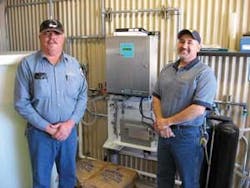Water Reuse: Experiences from the Santa Ana Pueblo
Unlike wastewater that is discharged into a receiving stream, reclaimed water requires maintenance of a residual disinfectant in the treated water to prevent recontamination during the reuse application. Neither UV nor membrane filtration, both common choices for discharged wastewater, offer a disinfection residual. Therefore, any wastewater treatment facility that wishes to recycle water must treat with a chlorine disinfectant in order to provide a measurable residual.
An excellent example of on-site generation for wastewater reuse lies in Sandoval County, New Mexico. About 20 miles north of Albuquerque is the Pueblo of Santa Ana, a leader in conservation efforts with their reclamation facility built in the late 1990s. The Tamayamé, the Native American Tribal members of the Pueblo, have resided there at least since the 1500s. In 2000, the Census Bureau reported the Pueblo's population as approximately 500. Despite its small size, the Pueblo has been very progressive about economic development.
The Pueblo now owns and operates several successful businesses that include the Hyatt Regency Tamaya Resort & Spa with 350 guestrooms, the Santa Ana Star Casino, and two upscale golf courses, among other small business enterprises. To help keep this development in line with their values, the Tribal Government formed the Santa Ana Department of Natural Resources (SADNR) in 1996. The SADNR focus is "… to develop and implement natural resource management programs that protect, preserve, and enhance natural resources for current and future tribal members".
The Pueblo had traditionally used an anaerobic, complete retention lagoon system to handle influent. The Santa Ana Tribal Utilities Authority regularly received complaints about the odor emitted by the lagoon system. The lagoons also occupied a large piece of valuable land that could have other uses on the Pueblo.
These issues led the Pueblo to consider a wastewater treatment facility. In keeping with their focus on natural resource conservation and future economic development, the Pueblo also wanted to reuse the treated effluent. As well as conserving resources, water reuse would save the Pueblo money. Considering the clear environmental benefits and peripheral advantages, the Tribal Council approved the plans to build the wastewater treatment facility in the late 1990s which would allow them to reuse the treated effluent.
Accordingly, the water coming from the community itself, along with the Hyatt Regency Tamaya Resort & Spa, the Santa Ana Star Casino, and other small businesses, is now purified and recycled for irrigation of the Twin Warriors Golf Club.
The effluent is treated through coagulation, a biological treatment process, and disinfection provided by an on-site generator. The wastewater treatment plant supplies approximately 50,000 gallons of treated effluent water to the golf course at a time. Effluent is supplemented with groundwater to meet the remaining irrigation needs.
When the Pueblo built their reclaimed water treatment facility in the late 1990s, they chose on-site hypochlorite generation to provide the residual disinfectant. The process of on-site generation uses salt, water, and power to create a chlorine-based disinfectant, eliminating the transport and storage of hazardous chemicals.
The salt feedstock is fully converted, resulting in negligible addition of sodium to the treated water and no negative impact to irrigated landscapes. Although the safety benefits of the hypochlorite generator were a positive aspect, the Pueblo struggled with lack of response from their original choice of manufacturer, as well as limited parts availability, with a minimum wait of 3 to 4 days to receive replacement parts.
Thus, when the Pueblo decided to upgrade their system in 2007, they chose to go with a local vendor of on-site generation equipment, installing a 10-pound mixed-oxidant generator manufactured by MIOX Corporation in Albuquerque, NM. This choice provided them with direct service from both the representative and manufacturer, as well as technical training sessions provided by MIOX on a quarterly basis.
After the unit was installed, the Pueblo observed a number of advantages over the previous on-site generation system. The Pueblo reports that the MIOX unit is much easier to operate, reducing maintenance time by about two-thirds. According to system operators, the previous unit required frequent manual calibration and cleaning of the brine pump, which took approximately four hours monthly. With the new unit's self-calibration feature, operators spend a maximum of 1 ½ hours per month on equipment maintenance. Operators also report a 50% reduction in salt consumption, from approximately four bags of salt per week with the previous system to only two bags of salt per week with the new, which equates to a significant savings in operating costs.
The MIOX mixed-oxidant system reduces chlorine demand and provides more effective treatment than the previous hypochlorite disinfectant. A layer of biofilm that was able to grow and thrive in the chlorine contact chamber with the old system peeled off after treatment with new system began. The biofilm matte moved through the chlorine contact chamber and was ultimately removed with the sludge.


